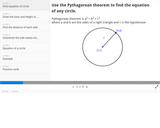
Slides showing steps to derive the equation of a circle, using the Pythagorean Theorem
- Subject:
- Geometry
- Mathematics
- Material Type:
- Interactive
- Provider:
- Michigan Virtual
- Date Added:
- 07/19/2019

Slides showing steps to derive the equation of a circle, using the Pythagorean Theorem

For this assessment task, students use pictures to solve measurement word problems.

For this assessment task, students use a drawing and an equation to solve measurement word problems.
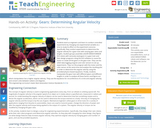
Students work as engineers and learn to conduct controlled experiments by changing one experimental variable at a time to study its effect on the experiment outcome. Specifically, they conduct experiments to determine the angular velocity for a gear train with varying gear ratios and lengths. Student groups assemble LEGO MINDSTORMS(TM) NXT robots with variously sized gears in a gear train and then design programs using the NXT software to cause the motor to rotate all the gears in the gear train. They use the LEGO data logging program and light sensors to set up experiments. They run the program with the motor and the light sensor at the same time and analyze the resulting plot in order to determine the angular velocity using the provided physics-based equations. Finally, students manipulate the gear train with different gears and different lengths in order to analyze all these factors and figure out which manipulation has a higher angular velocity. They use the equations for circumference of a circle and angular velocity; and convert units between radians and degrees.
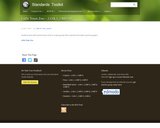
In this assessment task students will use data to create a picture graph and a bar graph. They will sort pictures into four categories. They also answer questions to compare the animals they graphed using addition and subtraction problems. An assessment task sheet and rubric are provided.

For this assessment task, students solve a word problem using a drawing and an equation.
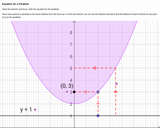
Image of parabola on coordinate plane, with hot spots indicating focus and directrix, along with an example of deriving the equation for a parabola given the focus and directrix.
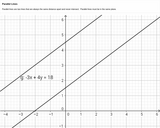
Image of parallel lines, image of perpendicular lines, and image of intersecting lines, each image followed by text in accordion of properties of eac.n

This resource is part of Tools4NCTeachers.
In this lesson, students will be figuring out the addends that add up to the correct sums. They will also be creating and solving equations with more than two addends.

This resource is part of Tools4NCTeachers.
In this lesson, students explore the communitive property in the context of a word problem to determine if students have the same number of items
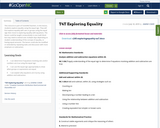
This resource is part of Tools4NCTeachers.
In this lesson, students explore equality using the equal sign. They will first explore equality with sets or groups using the equal sign then move to exploring equality with equations. The lesson could be taught consecutively in one math block but may need to extend over multiple days depending on student understanding of the concept of equality, or having equal amounts. The lesson could also be modified or extended by repeating tasks and discussion with more emphasis on subtraction.

This resource is from Tools 4 NC Teachers. It is intended to be used in Clusters 1 or 4 of Grade 3.

This task is from Tools 4 NC Teachers. It is intended to be used in Clusters 1 or 4 of Grade 3.

This lesson is part of Tools4NCTeachers.In this lesson, students practice solving unknown-addend problems by using addition strategies or changing to subtraction problems. Task cards and extension actvities are included.

This resource is from Tools4NCTeachers.In this lesson, students work with different quantities to determine if they have the same value / equal. The information is presented in a context, not simply in an equation format, so students will need to apply their understanding of problem solving and resulting equations along with computation in order to determine if the amounts are equal. Students will explain and defend their answers. This file includes lesson, student recording sheets, and printable exit tickets. Remix this lesson to include extension ideas or student work samples.

This resource is part of Tools4NCTeachers.
In this lesson, students develop their understanding of odd and even numbers. Students will begin to notice what is happening when an even and an even are added together, odd and odd, even and odd. They make generalizations by playing the game "Even Steven or Odd Rod".
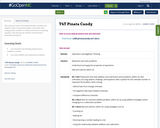
This resource is part of Tools4NCTeachers.
Students are asked to solve a real world problem, show their work using pictures, numbers or words, and record a matching equation. The task may be used for instructional or assessment purposes.

This resource is from Tools4NCTeachers. This is a set of nine (9) tasks, which may be used for instruction or assessment. Each attachment contains a separate task, rubric, and student recording sheet. The word problems in these tasks involve 'adding to' or 'taking from' a quantity. In these specific problems, the change is unknown. For example:There were 17 ducks in the pond. Some flew away, and now there are 8 ducks in the pond. How many ducks flew away?Remix this resource to include student work samples or addtional tasks.

This resource is from Tools4NCTeachers. This is a set of ten (10) tasks, which may be used for instruction or assessment. Each file contains a separate task, rubric, and recording sheets. The word problems in these tasks focus around making comparisons, where the difference between the two quantities is unknown. For example, students may find the difference between two measurements or between the two sets of objects.Remix this resource to include extension ideas or addtional tasks.

This resource is from Tools4NCTeachers. This task may be used for instruction or assessment. It focuses around a put-together/take apart problem where one of the addends is unknown. The file contains the task, rubric, and student recording sheet. Remix this resource to include student work samples or addtional tasks.